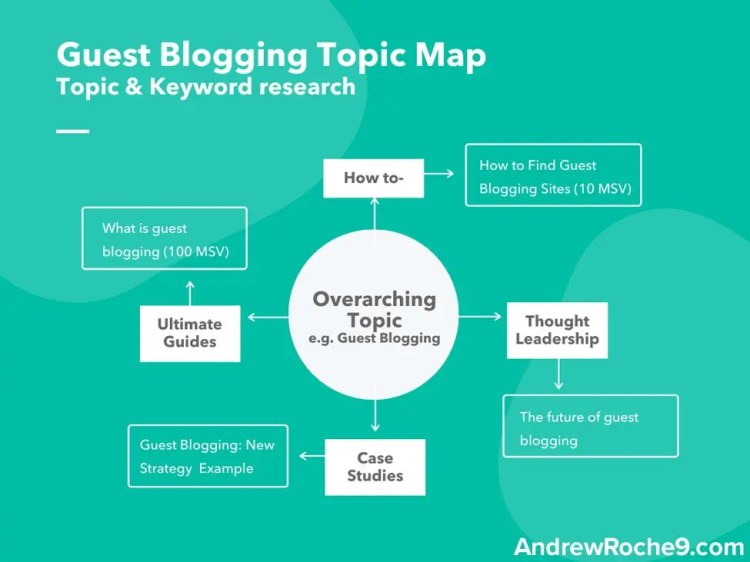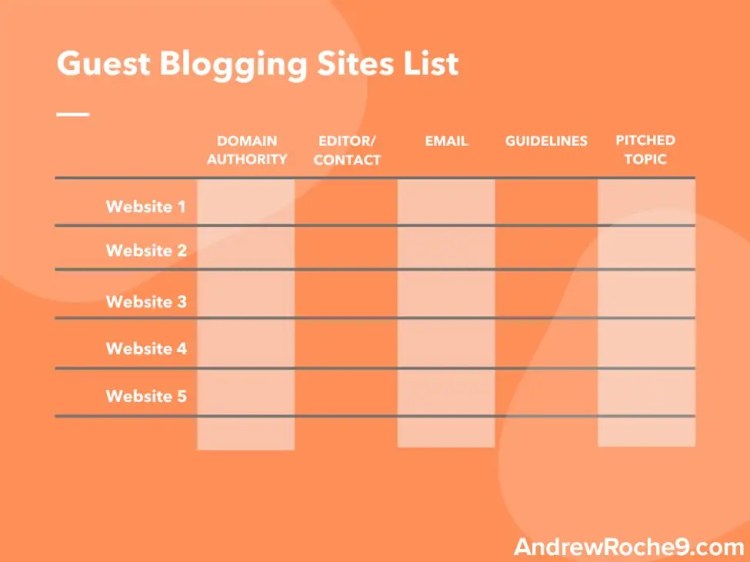The topic of guest blogging is one of the quickest ways to divide the digital marketing community. Don’t believe me? Walk into a room full of marketers, bring up guest blogging, and let me know how it goes. Some marketers will say that guest blogging is a total waste of time. Others will sing high praise and say that it is an essential element of their marketing strategy.
As with most polarized debates, the truth lies somewhere in the middle. Yes, guest blogging can be a waste of time and resources. However, if executed correctly, it can expedite your growth. In addition to the brand awareness component, guest blogging has the potential to be an ethical and sustainable method to build high-quality backlinks, which, in turn, improves your SEO rankings.
This is why I wanted to create this complete guide to guest blogging. The beauty is that anyone, from any industry, can understand and apply it to the overall marketing strategy.
This guide will show you how to develop a successful guest blogging strategy:
- Set SMART goals
- Select topics that will benefit your personal business goals
- Identify reputable guest blogging sites
- Reach out to potential partners
- Write a powerful post
- Track posts’ success over time
Before we dive into the above strategy, let’s lay a sturdy foundation and define the essence of guest blogging.
What is Guest Blogging?

Guest blogging is a form of content marketing in which one publishes articles for other websites. These articles include your byline and are typically highlighted as being written by a “guest author” or a “contributor.”
Each publication is different, but you may receive some form of compensation for your efforts. However, this is not always the case. Some publications will offer some sort of non-monetary compensation for your post. Such compensation can come in the form of backlinks to your personal website or social media accounts.
Now that we’ve defined guest blogging, let’s explore a handful of the core benefits.
Benefits of Guest Blogging
Here are a few of the more common benefits associated with guest blogging:
- Develop a profile as an industry expert and/or thought leader
- Grow your personal brand
- Grow your audience (social followers, subscribers, etc.)
- Improve your SEO performance
- Earn authoritative backlinks
- Forge relationships and drive fresh partnerships (co-marketing, job offers, etc.)
- Drive referral traffic to your website
- Improve your brand awareness
- Increase your inbound leads, users, and customers
Now that we’ve covered the more common benefits of guest blogging, let’s take a deep dive into each step of the process that will help you become a successful guest blogger for brand name publications.
Step-by-Step Guide to Become a Successful Guest Blogger
1.) Set SMART Goals
The first task in kicking off a successful guest blogging process is to set attainable and measurable goals. These goals can be related to your business performance (e.g. attracting more leads or clients) or your website performance (e.g. improving your search visibility or referral traffic).
Whatever your goal is, make it a SMART goal. When you identify a clear goal, it is far easier to pick your topics, the blogs for which you wish to guest blog, how frequently your write, etc. Furthermore, a SMART goal will tell you if this method is right for your business and how much you should invest in it moving forward.
If you’re fresh out of the starting blocks, here are five examples of goals that you can aim to achieve:
- Get X referral visits from your guest post OR increase referral traffic by X% via your guest post(s)
- Earn X leads from referral traffic from your guest post(s) OR increase the number of leads collected via your guest post(s) by X%
- Get X clients from your guest post(s) OR increase your client base via your guest post(s) by X%
- Improve your SEO performance or SERP visibility by X%
- Earn X high-quality backlinks to relevant content from your guest posts
Personally, I’m a fan of setting goals pertaining to referral visits, SEO traffic, and backlinks. Any change in these metrics can be traced back to guest blog posts with relative ease in most cases. Guest blogging can certainly influence your inbound stream of leads and clients, but correct attribution can be difficult to nail down.
Next up we’ll discuss keyword research and how it fuels your content creation process.

2.) Select Topics that Will Benefit Your Personal Business Goals
Guest blogging often fails when bloggers focus on the publication instead of the content.
In order to have a successful guest blogging program, you need to pick topics that serve your ultimate goal – whether that’s referral traffic, SEO performance, leads, or clients.
Whether you’re a seasoned blogger or just learning how to get your blog up and running, you should build a thriving guest blogging program. In order to accomplish this task, you need to pick topics that serve your ultimate goal, whether that’s referral traffic, SEO performance, leads, or clients.
You can start by making a shortlist of the top pages on your website that you want to promote and include in your future guest blogs. For each page, analyze your current status, like your monthly SEO traffic, and set a goal that you want to hit in a certain timeframe of guest blogging. You can have a larger overarching website goal as well as page-specific goals.
For each target page, pick a high-level topic that is relevant to your expertise and that your audience will find useful. Then you can start using keyword research tools like Ubersuggest or Ahrefs to fuel your bank of ideas for future guest posts.
Let’s say that your high-level goal is guest blogging. We could create different types of content under this umbrella:
- How-to articles for a practical guide on doing something interesting in your field or industry
- Thought leadership pieces that offer insights into what other professionals are thinking about and why they matter now more than ever before (think influencers)
- Case studies highlighting successful companies with similar goals as yours who mentor others through their own challenges while maintaining integrity at all times
- Ultimate guides that provide an all-encompassing overview of a medium to large topic

3.) Identify Reputable Guest Blogging Sites
Now that you’ve mapped out your content ideas, it’s time to find relevant publications. Start by putting together a list of target websites.

Here’s how you can identify guest blogging opportunities and populate your list:
- Use Advanced Search Operators — where you use advanced search operators such as “intext: submit a guest post.”
- Use Google Reverse Image Search — where you take the headshot of a popular guest blogger and you use it to find places where they’ve published before. These publications are likely to be open to guest blog submissions.
- Look for Lists of top websites that accept guest posts.
- Check your competitors’ backlinks
Next, you want to make sure that you prioritize your list and only pitch blogs that have
- Domain Authority of 40 or higher
- Spam Score of 3% or lower
- A thorough editorial process
4.) Conduct Guest Blogging Outreach
At this point in the process, you need to start thinking about how to pitch your guest post ideas.
As we touched on in the previous step, you want to target publications with a thorough editorial process. This means that you need to find the website’s guest blogging guidelines and then prepare your pitch.
I would suggest that you approach your blogger outreach process strategically. You can start with the keywords you found earlier and your target publication. Check if your target website already ranks for the topic of your choosing.
Once your pitch is ready, it’s time to find your contact person and reach out to them.
There are numerous methods you can use to entice your contact and get a response. A great way to earn a response is to ask yourself, “does my pitch offer value?”
You also want to avoid beating around the bush. If you’ve done your research, and have developed a portfolio of great content that ranks, then a straightforward pitch should do the trick.
Many marketers still use Google Sheets or Excel to track their contacts and responses. These tools are great, but they do not provide the means for you to track a plethora of valuable information. I’m personally a fan of Airtable due to the extent to which you can customize your database.
There are many awesome outreach tools out there and I’ve listed most of them at the end of this article.
Once you get the green light from your editor, it’s time to start fleshing out and writing an awesome initial draft!
Note: Many publications require you to include a complete draft in your initial pitch. Make sure you always read the guest blogging guidelines to ensure that your pitch includes all of the necessary elements.
5.) Write the Post

This is often the easiest step in the entire guest blogging process, especially if you cover a topic that you’re passionate about and have extensive expertise in. You just need to set aside the time, stay laser-focused, and start typing.
If you’re less than comfortable and/or confident with your writing, it’s totally okay to hire an editor to review your initial draft. In fact, I highly recommend it even if you’re a seasoned writer. It’s always a wise idea to have a second (or third) pair of eyes dissect your article and provide constructive criticism.
Here are 10 vital recommendations for writing guest posts that apply to writers of all levels:
- Write long-form content (1,000+ words) that is compelling
- Keep your paragraphs short and sweet so that they’re easy to consume and digest
- Make sure to optimize your post for on-page SEO – I’m a huge fan of the Yoast plugin for WordPress
- Use original images and graphs to make your post more linkable – Adobe Photoshop or Illustrator are my go-to tools for all graphics and Canva is a great option for novice designers
- Add quotes from friends, colleagues, and influencers when appropriate
- Incorporate links to your other guest posts
- Link to your own content when appropriate
- Include links to other publications that feature studies, data, thought leadership, etc.
- Link internally to other articles on your target publishers’ website
- Add your byline and explain why you are an expert on the topic you’re writing about
When you submit your final draft to the editor, make sure to include your author details (your full name, a brief bio, your social links so readers can connect with you, a headshot, and your website)
At this point, you’re ready to hit “send” and send your guest post to the editor.
You need to complete one final step before you consider this project done: measure your results.
6.) Track Your Posts’ Success Over Time

Taking this final step may seem daunting at first glance, but it is perhaps one of the most important.
You should always make sure you’re comparing your results to where you were at the start of this process (reference the first step about goal setting).
Depending on your goals, you can use a number of the various SEO tools to track different metrics. I’ve included a list of the top guest blogging tools you can employ in the next section.
Guest Blogging SEO
Earlier we discussed how to prioritize your opportunities based on Domain Authority and Spam Score, so it only makes sense that we explore the SEO element of guest blogging.
Check the Domain Authority of any website with Moz’s free domain SEO analysis tool!
According to a study by SEMRush, 53% of digital marketers believe that guest blogging (or guest posting) is the most effective way to build a strong backlink profile.
Another link-building study by Aira from 2020 shows that guest blogging is the third most effective way to build backlinks — 51% of respondents confirmed that they incorporate guest blogging into their overall marketing strategy.
Guest blogging is a popular SEO tactic since websites that accept guest posts typically allow authors to link back to their own content or resources — assuming that it makes sense for the reader. These links are typically placed in the body of the article, or in the authors’ bio.
Many times, blog editors place a no-follow tag on links from guest bloggers. In the past, no-follow links were seen as a “lower-value” backlink since they didn’t carry any authority. However, with recent updates, Google publically announced that even no-follow backlinks are viewed as signals by its ranking algorithm.
Don’t try to overdo it with guest blogging for the sake of building backlinks. If you disregard content quality and user experience, you’ll most likely end up harming your SEO performance and ultimately your reputation. Write to educate and entertain your audience and you’ll see positive results.
Top Tools for Guest Blogging
BuzzStream
BuzzStream helps you manage word-of-mouth marketing campaigns that create buzz, build links, and traffic your website by helping you “be found” via inbound marketing channels.
Respona
Respona is the all-in-one digital PR, blogger outreach, and link-building software that combines personalization with productivity. Respona’s mission is to allow brands to connect with relevant bloggers and journalists in their space to spread the word about their company online. Find outreach opportunities in real-time, create an automated email sequence, find direct, verified contact information, and truly personalize your campaign using Respona’s AI assistant, all in one platform.
JustReachOut
The JustReachOut software allows you to find the most relevant journalists, publications, press opportunities, podcasts, and broken links so you can pitch with confidence.
BuzzSumo
BuzzSumo shows you the most shared links and key influencers for any topic or website. Ideal for content strategy, outreach, and competitive research.
Clearscope
Clearscope helps content marketers grow their audience and search traffic by removing the guesswork behind the performance of their content.
RocketReach
RocketReach’s machine learning distills 1000s of public data points, discovering verified email, phone numbers, and social media profiles for over 450 million profiles, at 15 million companies worldwide.
Ahrefs
Ahrefs is an all-in-one SEO toolset that can help anyone to stay on top of their competitors, drive more search traffic and optimize their website.
SEMRush
Semrush is a leading online visibility management software-as-a-service platform. With over 50 products, tools, and add-ons across online visibility management, including tools for search, content, social media, and market research, data for more than 142 countries, seamless integration with Google and task management platforms, Semrush is a critical solution for all companies who are serious about online presence.
SimilarWeb
Shine a light on the digital world with Similarweb. The platform helps business leaders, analysts, and marketers easily discover the best opportunities, identify potential threats, and make business-critical decisions to grow website traffic and revenue.
Closing Thoughts
I hope that you feel better prepared to start developing your guest blogging strategy having read this article. The best strategy for your business and your context is always going to be the one you craft after endless trials and errors. That being said, don’t be afraid to just dive in and learn along the way.




